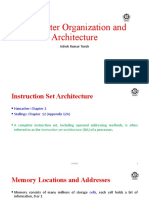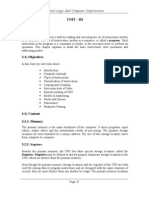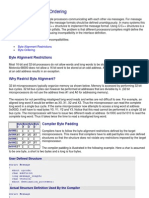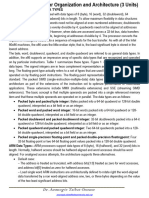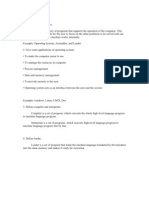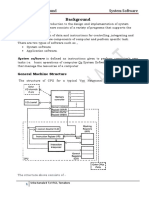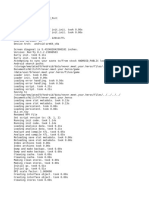0 ratings0% found this document useful (0 votes)
6 viewsDDCO Module 3 Chapter2 Final
DDCO Module 3 Chapter2 Final
Uploaded by
peepa PradeepCopyright:
© All Rights Reserved
Available Formats
Download as PPTX, PDF, TXT or read online from Scribd
DDCO Module 3 Chapter2 Final
DDCO Module 3 Chapter2 Final
Uploaded by
peepa Pradeep0 ratings0% found this document useful (0 votes)
6 views65 pagesOriginal Title
DDCO Module 3 Chapter2 Final Converted
Copyright
© © All Rights Reserved
Available Formats
PPTX, PDF, TXT or read online from Scribd
Share this document
Did you find this document useful?
Is this content inappropriate?
Copyright:
© All Rights Reserved
Available Formats
Download as PPTX, PDF, TXT or read online from Scribd
Download as pptx, pdf, or txt
0 ratings0% found this document useful (0 votes)
6 views65 pagesDDCO Module 3 Chapter2 Final
DDCO Module 3 Chapter2 Final
Uploaded by
peepa PradeepCopyright:
© All Rights Reserved
Available Formats
Download as PPTX, PDF, TXT or read online from Scribd
Download as pptx, pdf, or txt
You are on page 1of 65
Digital Design and Computer Organization
Module -3
Machine Instructions and Programs
Chapter 2 :Machine Instructions and Programs
Memory Location and Addresses
Memory Operations
Instruction and Instruction sequencing
Addressing Modes
Topics: 2.2, 2.3, 2.4, 2.5
Introduct
ion
we discuss how instructions are composed and study the ways in which sequences of
instructions are brought from the memory into the processor and executed to perform
a given task.
The addressing methods that are commonly used for accessing operands in
memory locations and processor registers are also presented.
These generic programs are specified at the assembly-language level, where
machine instructions and operand addressing information are represented by
symbolic names.
A complete instruction set, including operand addressing methods, is often
referred to as the instruction set architecture (ISA) of a processor.
we will present enough examples to illustrate the capabilities of a typical
instruction set.
2.1 Memory Locations and Addresses
The memory consists of many millions of storage cells, each of
which can store a
bit of information having the value 0 or 1.
Because a single bit represents a very
small amount of information, bits are
seldom handled individually.
The usual approach is to deal with them in groups of fixed size.
For this purpose, the memory is organized so that a group of n
bits can be stored or retrieved in a single, basic operation.
Each group of n bits is referred to as a word of information,
and n is called the
word length.
The memory of a computer can be schematically represented
as a collection of words, as shown in Figure 2.1.
Memory consists of
many millions of storage
cells, each of which can
store 1 bit.
Data is usually accessed
in n-bit group. n is called
word length.
Modern computers have word lengths that typically range from 16 to 64
bits.
If the word length of a computer is 32 bits, a single word can store a 32-
bit signed number or four ASCII-encoded characters, each occupying
8 bits, as shown in Figure 2.2.
A unit of 8 bits is called a byte.
Machine instructions may require one or more words for their
representation.
Examples of encoded information in a 32 bit word
Accessing the memory to store or retrieve a single item of
information, either a word or a byte, requires distinct names or
addresses for each location.
It is customary to use numbers from 0 to 2k − 1, for some suitable
value of k, as the addresses of successive locations in the memory.
Thus, the memory can have up to 2k addressable locations.
The 2k addresses constitute the address space of the computer.
For example, a 24-bit address generates an address space of 224
(16,777,216) locations.
2.1.1 Byte
Addressability
We have three basic information quantities to deal with: bit,
byte, and word.
A byte is always 8 bits, but the word length typically ranges from
16 to 64 bits.
It is impractical to assign distinct addresses to individual
bit locations in the
memory.
The most practical assignment is to have successive addresses
refer to successive byte locations in the memory.
This is the assignment used in most modern computers.
The term byte-addressable memory is used for this assignment.
Byte locations have addresses 0, 1, 2,.... Thus, if the word
length of the machine is 32 bits, successive words are located
at addresses 0, 4, 8,..., with each word consisting of four
2.1.2 Big-Endian and Little-Endian Assignments
There are two ways that byte addresses can be assigned across
words, as shown in Figure 2.3.
The name big-endian is used when lower byte addresses are
used for the more significant bytes (the leftmost bytes) of the
word.
The name little-endian is used for the opposite ordering,
where the lower byte
addresses are used for the less significant bytes (the rightmost
bytes) of the word.
The words “more significant” and “less significant” are
used in relation to the weights (powers of 2) assigned to bits
when the word represents a number.
Both little-endian and big-endian assignments are used in
commercial machines.
In both cases, byte addresses 0, 4, 8,..., are taken as the
addresses of successive words in the memory of a computer with
Byte and Word addressing
In addition to specifying the address ordering of bytes within a word, it is also
necessary to specify the labeling of bits within a byte or a word.
The most common convention, and is shown in Figure 2.2a.
It is the most natural ordering for the encoding of numerical data.
The same ordering is also used for labeling bits within a byte, that is, b7, b6,...,
b0, from left to right.
2.1.3 Word Alignment
Words are said to be aligned in memory if they begin at a byte address that is
a multiple of the number of bytes in a word
16 bit word : 0, 2, 4, ...
32 bit word : 0, 4, 8, ...
64 bit word : 0, 8, 16, ..
2.1.4 Accessing Numbers and
Characters
• A number usually occupies one word, and can be accessed in the memory by
specifying its word address.
• Similarly, individual characters can be accessed by their byte address.
• For programming convenience it is useful to have different ways of specifying
addresses in program instructions.
2.2 Memory
•Operations
Both program instructions and data operands are stored in the
memory.
• To execute an instruction, the processor control circuits must
cause the word (or words) containing the instruction to be
transferred from the memory to the processor.
• Operands and results must also be moved between the memory
and the processor.
• Two basic operations involving the memory are needed,
namely, Read and Write.
• The Read operation transfers a copy of the contents of a
specific memory location to the processor.
• The memory contents remain unchanged.
• To start a Read operation, the processor sends the address of the
desired location to the memory and requests that its contents be
read.
The Write operation transfers an item of information from the
processor to a specific memory location, overwriting the former
contents of that location.
To initiate a Write operation, the processor sends the address of
the desired location to the memory, together with the data to be
written into that location.
The memory then uses the address and data to perform the write.
2.3 Instructions and Instruction
Sequencing
The tasks carried out by a computer program consist of a sequence of small
steps, such as adding two numbers, testing for a particular condition, reading a
character from the keyboard, or sending a character to be displayed on a display
screen.
A computer must have instructions capable of performing four types of
operations:
• Data transfers between the memory and the processor registers
• Arithmetic and logic operations on data
• Program sequencing and control
• I/O transfers
2.3.1 Register Transfer
Notation
We need to describe the transfer of information from one
location in a computer to another.
Possible locations that may be involved in such transfers are
memory locations, processor registers, or registers in the I/O
subsystem.
Most of the time, we identify such locations symbolically with
convenient names.
For example, names that represent the
addresses of memory locations may be LOC,
PLACE, A, or VAR2.
Predefined names for the processor registers may be R0 or R5.
Registers in the I/O subsystem may be identified by names
such as DATAIN or OUTSTATUS.
To describe the transfer of information, the contents of any
location are denoted by placing square brackets around its
name.
Thus, the expression R2 ← [LOC] means that the contents of
Example: consider the operation that adds the contents of
registers R2 and R3, and places their sum into register R4.
This action is indicated as R4 ← [R2]+[R3].
This type of notation is known as Register Transfer Notation
(RTN).
Note that the righthand side of an RTN expression always
denotes a value, and the left-hand side is the name of a
location where the value is to be placed, overwriting the old
contents of that location.
In computer jargon, the words “transfer” and “move” are
commonly used to mean “copy.”
Transferring data from a source location A to a destination
location B means that
the contents of location A are read and then written into location
B.
In this operation, only the contents of the destination will
2.3.2 Assembly-Language
Notation
We need another type of notation to represent machine
instructions and programs.
For this, we use assembly language.
For example, a generic instruction that causes the transfer
described above, from memory location LOC to processor register
R2, is specified by the statement
Load R2, LOC.
The contents of LOC are unchanged by the execution of this
instruction, but the old contents of register R2 are overwritten.
The name Load is appropriate for this instruction, because the
contents read from a memory location are loaded into a
processor register.
The second example of adding two numbers contained in
processor registers R2 and R3 and placing their sum in R4 can
be specified by the assembly-language statement Add R4, R2,
R3.
In this case, registers R2 and R3 hold the source operands,
An instruction specifies an operation to be performed and the
operands involved.
In the above examples, we used the English words Load and
Add to denote the required operations.
In the assembly-language instructions of actual (commercial)
processors, such operations are defined by using mnemonics,
which are typically abbreviations of the words describing the
operations.
For example, the operation Load may be written as LD,
while the operation Store, which transfers a word from a
processor register to the memory, may be written as STR or
ST.
Assembly languages for different processors often use
different mnemonics for a given operation.
To avoid the need for details of a particular assembly language
at this early stage, we will continue the presentation in this
chapter by using English words rather than processor-specific
mnemonics.
2.3.3 RISC and CISC
Instruction
One of the Setsmost important characteristics that distinguish
different computers is the nature of their instructions.
There are two fundamentally different approaches in the design of
instruction sets for modern computers.
One popular approach is based on the premise that higher
performance can be achieved if each instruction occupies exactly
one word in memory, and all operands needed to execute a given
arithmetic or logic operation specified by an instruction are already
in processor registers.
This approach is conducive to an implementation of the
processing unit in which the various operations needed to process
a sequence of instructions are performed in “pipelined” fashion to
overlap activity and reduce total execution time of a program.
The restriction that each instruction must fit into a single word
reduces the complexity and the number of different types of
instructions that may be included in the instruction set of a
computer. Such computers are called Reduced Instruction Set
• An alternative to the RISC approach is to make use of more
complex instructions which may span more than one word of
memory, and which may specify more complicated operations.
• This approach was prevalent prior to the introduction of the RISC
approach in the
1970s.
• Although the use of complex instructions was not originally
identified by any particular label, computers based on
this idea have been subsequently called Complex
Instruction Set Computers (CISC).
2.3.4 Introduction to RISC
Instruction Sets
Two key characteristics of RISC instruction sets are:
Each instruction fits in a single word.
A load/store architecture is used, in which
Memory operands are accessed only using Load and Store
instructions.
All operands involved in an arithmetic or logic operation
must either be in processor registers, or one of the operands
may be given explicitly within the instruction word.
At the start of execution of a program, all
instructions and dataused in the program are stored in
the memory of a computer.
Processor registers do not contain valid operands at that time.
If operands are expected to be in processor registers before they
can be used by an instruction, then it is necessary to first bring
these operands into the registers.
This task is done by Load instructions which
copy the contents of a memory location into a
processor register.
Load instructions are of the form
Load destination, source or more specifically
Load processor_ register, memory _location
The memory location can be specified in several ways.
The term addressing modes is used to refer to the different
ways in which this may be accomplished.
We say that Add is a three-operand, or a three-address,
instruction of the form
Add destination, source1, source2
Store instruction is of the form
Store source, destination
the source is a processor register and the destination is a
memory location.
Observe that in the Store instruction the source and
destination are specified in the reverse order from the Load
instruction; this is a commonly used convention.
Add R3, R2, R3
Store R3, C
2.3.5 Instruction Execution and Straight-Line
Sequencing
How this program is executed?
The processor contains a register called the program counter
(PC), which holds the address of the next instruction to be
executed.
To begin executing a program, the address of its first instruction (i
in our example) must be placed into the PC.
Then, the processor control circuits use the information in the
PC to fetch and execute instructions, one at a time, in the
order of increasing addresses. This is called straight-line
sequencing.
During the execution of each instruction, the PC is incremented
by 4 to point to the next instruction. Thus, after the Store
instruction at location i + 12 is executed, the PC contains the
value i + 16, which is the address of the first instruction of the
next program segment.
Executing a given instruction is a two-phase procedure. In the
first phase, called instruction fetch, the instruction is fetched
• At the start of the second phase, called instruction execute,
the instruction in IR is examined to determine which
operation is to be performed.
• The specified operation is then performed by the processor.
• This involves a small number of steps such as fetching operands
from the memory or from processor registers, performing
an arithmetic or logic operation, and storing the result in the
destination location.
• At some point during this two-phase procedure, the
contents of the PC are advanced to point to the next
instruction.
• When the execute phase of an instruction is completed, the
PC contains the address of the next instruction, and a
new instruction fetch phase can begin.
2.3.6 Branching
Consider the task of adding a list of n numbers.
The program outlined in Figure 2.5 is a generalization of the
program in Figure 2.4.
The addresses of the memory locations containing the n
numbers are symbolically given as NUM1, NUM2,..., NUMn, and
separate Load and Add instructions are used to add each
number to the contents of register R2.
After all the numbers have been added, the result is placed in
memory location
SUM.
Instead of using a long list of Load and Add instructions, as in
Figure 2.5, it is possible to implement a program loop in which
the instructions read the next number in the list and add it to
the current sum.
To add all numbers, the loop has to be executed as many
The body of the loop is a straight-line sequence of instructions
executed repeatedly.
It starts at location LOOP and ends at the instruction
Branch_if_[R2]>0.
During each pass through this loop, the address of the next list
entry is determined, and that entry is loaded into R5 and added to
R3.
For now, we concentrate on how to create and control a program
loop.
Assume that the number of entries in the list, n, is stored in
memory location N, as shown.
Register R2 is used as a counter to determine the
number of times the loop is
executed.
Hence, the contents of location N are loaded into register R2 at
the beginning of the program.
Then, within the body of the loop, the instruction reduces the
We now introduce branch instructions.
This type of instruction loads a new address into the program counter.
As a result, the processor fetches and executes the instruction at this new
address, called the branch target, instead of the instruction at the location
that follows the branch instruction in sequential address order.
A conditional branch instruction causes a branch only if a specified condition is
satisfied.
If the condition is not satisfied, the PC is incremented in the normal way,
and the next instruction in sequential address order is fetched and executed.
In the program in Figure 2.6, the instruction Branch_if_[R2]>0 LOOP is a
conditional branch instruction that causes a branch to location LOOP if the
contents of register R2 are greater than zero.
This means that the loop is repeated as long as there are entries in the list
that are yet to be added to R3.
At the end of the nth pass through the loop, the Subtract instruction produces
a value of zero in R2,
and, hence, branching does not occur.
Instead, the Store instruction is fetched and executed. It moves the final
result from R3 into memory location SUM.
For example, the instruction that implements the action
Branch_if_[R4]>[R5] LOOP may be written in generic
assembly language as Branch_greater_than R4, R5, LOOP or
using an actual mnemonic as BGT R4, R5, LOOP.
It compares the contents of registers R4 and R5, without
changing the contents of either register.
Then, it causes a branch to LOOP if the contents of R4 are
greater than the contents of R5.
2.3.7 Generating Memory
Addresses
Let us return to Figure 2.6. The purpose
of the instruction block starting
at LOOP is to add successive numbers from the list during each pass through
the loop.
Hence, the Load instruction in that block must refer to a different address
during each pass.
How are the addresses specified?
The memory operand address cannot be given directly in a single Load
instruction in the loop.
Otherwise, it would need to be modified on each pass through the loop.
As one possibility, suppose that a processor register, Ri, is used to hold the
memory address of an operand.
If it is initially loaded with the address NUM1 before the loop is entered and
is then incremented
by 4 on each pass through the loop, it can provide the needed capability.
This situation, and many others like it, give rise to the need for flexible ways to
specify the address of an operand.
The instruction set of a computer typically provides a number of such
2.4 Addressing Modes
Programs are normally written in a high-level language,
which enables the programmer to conveniently describe the
operations to be performed on various data structures.
When translating a high-level language program into
assembly language, the compiler generates appropriate
sequences of low-level instructions that implement the desired
operations.
The different ways for specifying the locations of instruction
operands are known as addressing modes.
In this section we present the basic addressing modes
found in RISC-style processors.
A summary is provided in Table 2.1, which also includes the
assembler syntax we will use for each mode.
The assembler syntax defines the way in which instructions and
the addressing modes of their operands are specified.
2.4.1 Implementation of Variables and Constants
Variables are found in almost every computer program.
In assembly language, a variable is
represented by allocatinga register or a memory location
to hold its value.
This value can be changed as needed using appropriate
instructions.
The program in Figure 2.5 uses only two addressing modes to
access variables.
We access an operand by specifying the name of the register or
the address of the
memory location where the operand is located.
The precise definitions of these two modes are:
Register mode—The operand is the contents of a processor
register; the name of the register is given in the instruction.
The instruction Add R4, R2, R3 uses the Register mode for all
three operands.
Registers R2 and R3 hold the two source operands, while R4 is
the destination.
The Absolute mode can represent global variables in a
program.
A declaration such as Integer NUM1, NUM2, SUM;
In a high-level language program will cause the compiler to
allocate a memory
location to each of the variables NUM1, NUM2, and SUM.
Whenever they are referenced later in the program, the
compiler can generate assembly-language instructions that
use the Absolute mode to access these variables.
The Absolute mode is used in the instruction Load R2,
NUM1 which loads the value in the memory location NUM1 into
register R2
Constants representing data or addresses are also found in
almost every computer
program.
Such constants can berepresented in assembly
language using the Immediate addressing mode.
Immediate mode—The operand is given explicitly in the instruction.
For example, the instruction Add R4, R6, 200immediate adds the
value 200 to the contents of register R6, and places the result into
register R4.
Using a subscript to denote the Immediate mode is not
appropriate in assembly languages.
A common convention is to use the number sign (#) in front of
the value to indicate that this value is to be used as an immediate
operand.
Hence, we write the instruction above in the form Add R4,
R6, #200 In the addressing modes that follow, the instruction
does not give the operand or its address explicitly.
2.4.2 Indirection and Pointers
The program in Figure 2.6 requires a capability for modifying
the address of the
memory operand during each pass through the loop.
A good way to provide this capability is to use a processor
register to hold the address of the operand.
The contents of the register are then changed (incremented)
during each pass to
provide the address of the next number in the list that has to be
accessed.
The register acts as a pointer to the list, and we say that an
item in the list is accessed indirectly by using the address in the
register.
The desired capability is provided by the indirect addressing
mode.
Indirect mode—The effective address of the operand is the
We denote indirection by placing the name of the register
given in the instruction in parentheses as illustrated in Figure 2.7
and Table 2.1.
To execute the Load instruction in Figure 2.7, the
processor uses the value B, which is in register R5, as
the effective address of the operand.
It requests a Read operation to fetch the contents of location B
in the memory.
The value from the memory is the desired operand, which the
processor loads into register R2.
Indirect addressing through a memory
location is also possible, but it is found only in CISC-
style processors.
As another example of pointers, consider the C-language
statement A = *B;
where B is a pointer variable and the ‘*’
symbol is the operator for indirect accesses.
This statement causes the contents of the memory location
pointed to by B to be loaded into memory location A.
The statement may be compiled into
Load R2 B
Load R3
(R2) Store
R3
A Indirect
addressin
g through
registers
2.4.3 Indexing and Arrays
In an assembly-language program, whenever a constant such as the value X
is needed, it may be
given either as an explicit number or as a symbolic name representing a
numerical value.
The way in which a symbolic name is associated with a specific numerical
value.
When the instruction is translated into machine code, the constant X is
given as a part of the instruction and is restricted to fewer bits than the word
length of the computer.
Since X is a signed integer, it must be sign-extended to the register length
before being added to
the contents of the register.
Figure 2.9 illustrates two ways of using the Index mode.
In Figure 2.9a, the index register, R5, contains the address of a
memory location, and the value X defines an offset (also called a
displacement) from this address to the location where the operand is
found.
An alternative use is illustrated in Figure 2.9b. Here, the constant X
corresponds to a memory
address, and the contents of the index register define the offset to the
To see the usefulness of indexed addressing, consider a simple example
involving a list of test scores for students taking a given course.
Assume that the list of scores, beginning at location LIST, is structured as
shown in Figure 2.10.
A four-word memory block comprises a record that stores the relevant
information for each student.
Each record consists of the student’s identification number (ID), followed by
the scores the student
earned on three tests.
There are n students in the class, and the value n is stored in location N
immediately in front of the list.
The addresses given in the figure for the student IDs and test scores
assume that the memory is
byte addressable and that the word length is 32 bits.
We should note that the list in Figure 2.10 represents a two-dimensional array
having n rows and four columns.
Each row contains the entries for one student, and the columns give the IDs
and test scores
Suppose that we wish to compute the sum of all scores obtained on each of
the tests and store these three sums in memory locations SUM1, SUM2, and
SUM3. A possible program for this task is given in Figure 2.11.
THANK
YOU
You might also like
- Assembly Programming:Simple, Short, And Straightforward Way Of Learning Assembly LanguageFrom EverandAssembly Programming:Simple, Short, And Straightforward Way Of Learning Assembly LanguageRating: 5 out of 5 stars5/5 (2)
- National Blood Bank Network System (Nbbnets) Preparedness ChecklistDocument3 pagesNational Blood Bank Network System (Nbbnets) Preparedness ChecklistKathrine Ann Favorito50% (2)
- Chapter - 2 Instruction Set Architecture 2.1 Memory Locations and AddressesDocument11 pagesChapter - 2 Instruction Set Architecture 2.1 Memory Locations and AddressesAjay RavuriNo ratings yet
- COA Module 2Document89 pagesCOA Module 2shashidh1234No ratings yet
- COA ClassSlideChapter2 (1)Document47 pagesCOA ClassSlideChapter2 (1)ssedits050No ratings yet
- DDCO Module 3 Chapter2 Final 1Document65 pagesDDCO Module 3 Chapter2 Final 1Aishwarya ANo ratings yet
- Machine Instructions and ProgramsDocument1 pageMachine Instructions and ProgramsSrikanthNo ratings yet
- Machine Instructions and ProgramsDocument1 pageMachine Instructions and ProgramsSrikanthNo ratings yet
- Coa Module 2Document104 pagesCoa Module 2sahanasonu568No ratings yet
- rohini_94515057847Document7 pagesrohini_94515057847jaydeepghosh2016No ratings yet
- Memory Locations and AddressesDocument3 pagesMemory Locations and AddressesaljufmuhammadNo ratings yet
- Computer Organization and Architecture: Ashok Kumar TurukDocument54 pagesComputer Organization and Architecture: Ashok Kumar TurukSatya DasNo ratings yet
- CSE 243: Introduction To Computer Architecture and Hardware/Software InterfaceDocument26 pagesCSE 243: Introduction To Computer Architecture and Hardware/Software Interfaceachaparala4499No ratings yet
- Computer OrganisationDocument17 pagesComputer Organisationkijanavictor96No ratings yet
- Number of Bits Required For Memory AddressDocument11 pagesNumber of Bits Required For Memory Addressb121012No ratings yet
- Module 2 - UpdatedDocument44 pagesModule 2 - UpdatedsaragaNo ratings yet
- Module 2 - CompleteDocument58 pagesModule 2 - CompletesaragaNo ratings yet
- Module#2 ISADocument15 pagesModule#2 ISAGayathri potnuru JioNo ratings yet
- Unit 1&2Document18 pagesUnit 1&2fopahprincely01No ratings yet
- COA SECTION B SOLUTIONDocument6 pagesCOA SECTION B SOLUTIONkumardinesh9560632044No ratings yet
- Memory Location & Addresses - 2Document7 pagesMemory Location & Addresses - 2SwatiNo ratings yet
- Module 1: Basic Structure of Computers 1.1 Basic Operational ConceptsDocument34 pagesModule 1: Basic Structure of Computers 1.1 Basic Operational Conceptsyashu JNo ratings yet
- CO Module2Document20 pagesCO Module2sadi22eceNo ratings yet
- Mi Chapter2Document56 pagesMi Chapter2babil_88No ratings yet
- Unit Ii: Machine Instructions & ProgrammesDocument7 pagesUnit Ii: Machine Instructions & ProgrammesdvadoneNo ratings yet
- Computer Organization Concise NotesDocument57 pagesComputer Organization Concise NoteschutiyaNo ratings yet
- Unit - Iii 3.0) Introduction: Digital Logic and Computer OrganizationDocument34 pagesUnit - Iii 3.0) Introduction: Digital Logic and Computer OrganizationJit AggNo ratings yet
- CS330 Operating System Part VDocument13 pagesCS330 Operating System Part VHarsh BihanyNo ratings yet
- Coal HandoutsDocument18 pagesCoal HandoutsSaeNo ratings yet
- Memories Notes1Document12 pagesMemories Notes1cireriNo ratings yet
- Read and Write Operations in MemoryDocument2 pagesRead and Write Operations in Memoryusman khanNo ratings yet
- Instruction Set and Addressing ModesDocument14 pagesInstruction Set and Addressing ModesAastha KohliNo ratings yet
- Assembly Word SheetDocument7 pagesAssembly Word SheetnazmulNo ratings yet
- Advanced Microprocessors 8086Document58 pagesAdvanced Microprocessors 8086Melaku Tegegne100% (8)
- MCS12Document65 pagesMCS12manigandankindlyNo ratings yet
- MCS 012Document65 pagesMCS 012Vishal ThakorNo ratings yet
- Co 2nd ChapterDocument11 pagesCo 2nd ChapterPriyanka H VNo ratings yet
- Some Important Previous Year Question Solutions (CA) - 1Document10 pagesSome Important Previous Year Question Solutions (CA) - 1shivammishra492002No ratings yet
- Co Module1 Notes 21schemeDocument14 pagesCo Module1 Notes 21schemeShivam KumarNo ratings yet
- Computer OrganisationDocument27 pagesComputer OrganisationAmandeep SharmaNo ratings yet
- Lab 2Document12 pagesLab 2DavidNo ratings yet
- Coa-2-Marks-Q & ADocument30 pagesCoa-2-Marks-Q & AArup RakshitNo ratings yet
- Byte Alignment and OrderingDocument9 pagesByte Alignment and OrderingrodriguesvascoNo ratings yet
- Unit 2Document49 pagesUnit 2ladukhushi09No ratings yet
- Instruction Set ArchitectureDocument92 pagesInstruction Set ArchitectureAzka GilaniNo ratings yet
- CPU Organisation: Instructions and Instruction SequencingDocument30 pagesCPU Organisation: Instructions and Instruction SequencingSamit NagNo ratings yet
- Documento Sin TítuloDocument5 pagesDocumento Sin TítuloPablo Alcantud BenedictoNo ratings yet
- CAO - Mod1 Mymry, Adress, Adressing ModesDocument47 pagesCAO - Mod1 Mymry, Adress, Adressing ModesvkvNo ratings yet
- CSC 315 Notes 4Document9 pagesCSC 315 Notes 4fortunedako2No ratings yet
- Addressing Modes: Computer Organization & ArchitectureDocument20 pagesAddressing Modes: Computer Organization & ArchitectureGahan A V GowdaNo ratings yet
- Samara University College of Engineering and Technology Computer ScienceDocument32 pagesSamara University College of Engineering and Technology Computer Sciencehaileamalk12No ratings yet
- AnnaDocument73 pagesAnnaDriti DasNo ratings yet
- Organisation of CompDocument7 pagesOrganisation of CompAditya KumarNo ratings yet
- Instructions: Assembly Language: 2.1 Instructions and Instruction SetDocument5 pagesInstructions: Assembly Language: 2.1 Instructions and Instruction SetRoberto Jr VelascoNo ratings yet
- SS VVFGC NewDocument84 pagesSS VVFGC NewArthiNo ratings yet
- Answer of Q.2: Figure 1: A Generic ALU That Has 2 Inputs and 1 OutputDocument12 pagesAnswer of Q.2: Figure 1: A Generic ALU That Has 2 Inputs and 1 OutputAmit JainNo ratings yet
- S3-Lesson IIIDocument26 pagesS3-Lesson IIIEdouard Mvogo BilegueNo ratings yet
- BCA 4 DECOA CPU Instruction Set Architecture 1Document10 pagesBCA 4 DECOA CPU Instruction Set Architecture 1aviraj112001No ratings yet
- cs2304 System Software 2 Marks and 16 Marks With AnswerDocument18 pagescs2304 System Software 2 Marks and 16 Marks With Answermanojkumar024No ratings yet
- Practical Reverse Engineering: x86, x64, ARM, Windows Kernel, Reversing Tools, and ObfuscationFrom EverandPractical Reverse Engineering: x86, x64, ARM, Windows Kernel, Reversing Tools, and ObfuscationNo ratings yet
- ZXF01U03Document4 pagesZXF01U03Naresh ChNo ratings yet
- DP PatternsDocument10 pagesDP PatternsNetriderTheThechieNo ratings yet
- Install Kali Samsung ChromebookDocument4 pagesInstall Kali Samsung ChromebookgejibNo ratings yet
- Proposal Kebutuhan Also (Kantor Also & Maktabah)Document6 pagesProposal Kebutuhan Also (Kantor Also & Maktabah)hudzaifahejaNo ratings yet
- DUF ViewerDocument65 pagesDUF ViewermohrandrasNo ratings yet
- E-Ink Electronic Nameplate: Installation and Operating ManualDocument14 pagesE-Ink Electronic Nameplate: Installation and Operating ManualJewan RamlalNo ratings yet
- Fig. 1: Block Diagram Showing Architecture of AVR MicrocontrollerDocument30 pagesFig. 1: Block Diagram Showing Architecture of AVR MicrocontrollerPranav PrNo ratings yet
- Computer Overview PartDocument6 pagesComputer Overview PartSinghNo ratings yet
- Practise Quiz Ccd-333 Exam (01-2014) - Cloudera Quiz LearningDocument44 pagesPractise Quiz Ccd-333 Exam (01-2014) - Cloudera Quiz LearningratneshkumargNo ratings yet
- Themes InstallationDocument5 pagesThemes InstallationbongNo ratings yet
- Huawei h19 110 v2.0 Certsdeals Actual Questions by Jenkins 15 04 2024 8qaDocument12 pagesHuawei h19 110 v2.0 Certsdeals Actual Questions by Jenkins 15 04 2024 8qaAhmet ELMASNo ratings yet
- Timeline of The IT ERADocument23 pagesTimeline of The IT ERAJohn Gil Talangan PadieNo ratings yet
- Epson LQ 300 II DatasheetDocument2 pagesEpson LQ 300 II DatasheetDonny AdityaNo ratings yet
- Laporan Penjualan Bulan April 2019Document52 pagesLaporan Penjualan Bulan April 2019rubik ultramanNo ratings yet
- PLT Test Center Technical Requirements - CCTDocument16 pagesPLT Test Center Technical Requirements - CCTsajidkhanNo ratings yet
- 25.1.2 Lab - Install The CCNP Virtual MachineDocument2 pages25.1.2 Lab - Install The CCNP Virtual MachineEl hadawi MohamedNo ratings yet
- What Is JSONDocument9 pagesWhat Is JSONMusammat SaminaNo ratings yet
- MCQs For Computer Science 10th BISEDocument6 pagesMCQs For Computer Science 10th BISEH S Wajid Hussain88% (17)
- BusesDocument5 pagesBusesderry6271No ratings yet
- Choose Right Approach Mobile App DevelopmentDocument9 pagesChoose Right Approach Mobile App DevelopmentAditya RajNo ratings yet
- LogDocument2 pagesLoganaya.cuellar.andresNo ratings yet
- Colab TutorialDocument21 pagesColab Tutorialzhangchelsea9No ratings yet
- ELECTRONIC DATA PROCESSING and COMPUTER SYSTEMS BSCE 1A G3 - ReportDocument32 pagesELECTRONIC DATA PROCESSING and COMPUTER SYSTEMS BSCE 1A G3 - ReportcdaineredNo ratings yet
- Pci Bus End Point BlockDocument178 pagesPci Bus End Point Blockbkrishna_8888460% (1)
- Buy 13-Inch MacBook Pro - Apple (IN)Document1 pageBuy 13-Inch MacBook Pro - Apple (IN)dummy page7007No ratings yet
- Atm Database SystemDocument30 pagesAtm Database SystemPrateek Saini57% (14)
- Etoken Anywhere 8.1 Admin Guide Rev ADocument101 pagesEtoken Anywhere 8.1 Admin Guide Rev Atall27100% (1)
- PDF To MailDocument5 pagesPDF To MailJackson BorsattoNo ratings yet











